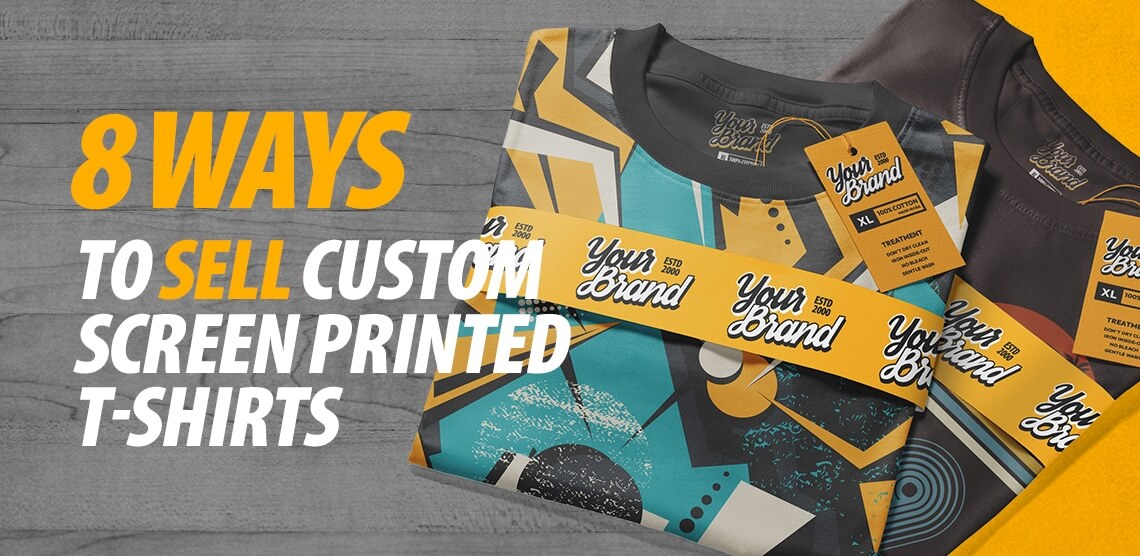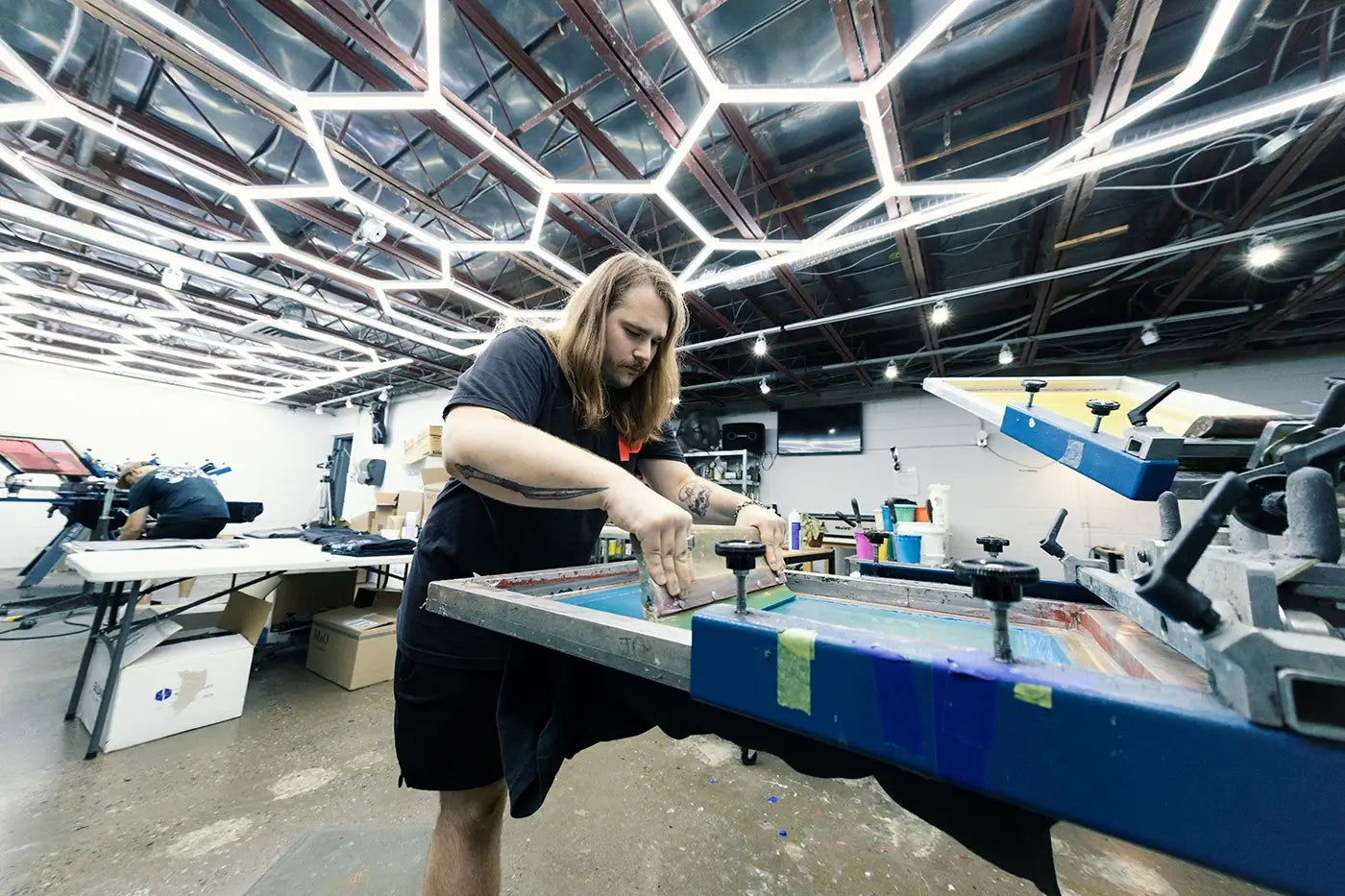Premium Screen Printing Kit for Business Startups
Premium Screen Printing Kit for Business Startups
Blog Article
Screen Printing Uncovered: Whatever You Need to Understand About T-Shirt and Garment Printing Methods
Screen printing is an interesting approach that combines art with method, supplying endless possibilities for creative thinking. Prepared to explore the vital components that make display printing an art type?
The Essentials of Screen Printing: Exactly How It Functions
When you dive into screen printing, you'll uncover it's both a science and an art. At its core, display printing involves developing a pattern, or display, that permits ink to pass through only in details areas.
Next, you'll mix your inks and prepare your printing surface area. Position the screen over the material, then utilize a squeegee to press ink with the display onto the garment. This process requires precision, as you want clear, lively prints. After printing, you'll heal the ink with warmth, guaranteeing it sticks to the fabric and lasts via washes. Each step is necessary, and grasping them will raise your display printing skills, changing basic garments right into unique, expressive pieces.
Kinds Of Screen Printing Strategies
Once you understand the basics of screen printing, it's time to check out the various techniques that can elevate your designs. One prominent approach is typical screen printing, where ink is pressed with a stenciled screen. This strategy is excellent for bold, vivid shades. There's water-based ink printing, which provides a softer feeling and is environment-friendly, yet it calls for a different technique to treating.
An additional choice is plastisol printing, recognized for its resilience and brilliant colors, making it a preferred for several brand names. Experiment with halftone printing to create gradient impacts and detailed styles.
Important Tools for Display Printing
To attain spectacular cause screen printing, having the ideal devices is essential. Initially, you'll need a sturdy display printing frame, which holds the mesh that transfers your layout onto the garment. Next off, purchase premium mops; these are crucial for applying ink evenly throughout the display. You'll also require a great direct exposure unit to create your displays, in addition to a washout booth for cleansing them after usage. A reliable warm source, like a conveyor clothes dryer or warm press, is critical for curing your prints to assure durability. Do not forget a proper work area, geared up with tables and storage for your products. Finally, protective equipment, such as handwear covers and masks, will certainly maintain you risk-free from chemicals and inks. With the right tools, you'll be well on your means to creating professional-quality prints.
Selecting the Right Inks and Materials
When selecting inks and materials for display printing, you require to think about the type of ink that functions finest for your job. Assume concerning material compatibility to ensure your designs look last and terrific lengthy. Also, check out eco-friendly ink choices to make your printing procedure extra lasting.
Kinds Of Screen Inks
Choosing the right screen ink is essential for achieving vibrant, durable prints that satisfy your project's needs. There are several kinds of screen inks to check out. Specialized inks, such as glow-in-the-dark or metal, can add unique impacts to your designs.

Material Compatibility Considerations
Understanding fabric compatibility is crucial for attaining top quality screen prints, specifically considering that various materials respond distinctly to numerous inks. When choosing inks, take into consideration the fabric type-- cotton, polyester, or blends. For cotton, water-based inks function well, providing soft qualities and breathability. Polyester, on the other hand, usually requires plastisol inks for much better attachment and lively shades. You might require to utilize a mix of both types if you're publishing on blends. Always examine your inks on example material to guarantee they adhere appropriately and keep color stability. Furthermore, remember that material weight and appearance can affect the last result, so picking the right ink and product combo is important for your job's success.
Eco-Friendly Ink Options
Green inks are coming to be a popular choice for display printers that desire to decrease their environmental effect while maintaining quality. When selecting inks, think about water-based inks, which are much less unsafe and simpler to cleanse up compared to conventional solvents.
Additionally, look for inks made from eco-friendly sources, such as soy or vegetable-based options. By choosing the appropriate inks and products, you'll not only create sensational designs but additionally add to a much more sustainable printing procedure. Make the switch, and your prints will certainly reflect your commitment to the setting!
Preparing Your Design for Display Printing

File Layout Demands
To assure your layout looks lively and sharp on material, you'll need to pay close interest to file format requirements for screen printing. Make sure your layout has a transparent history to protect against unwanted white sides on your prints. Keep shade modes in mind; CMYK is basic for screen printing, so convert your RGB develops as necessary.
Color Splitting Up Strategies
Shade splitting up is a vital action in preparing your layout for display printing, and understanding it can substantially enhance your print top quality. You'll need to damage your layout right into individual colors, as each color needs a separate display throughout printing. Beginning by determining all the shades in your design and create layers for each one. You can make use of software application like Adobe Photoshop or Illustrator to separate and separate colors efficiently. Be particular to conserve each layer as a different data, usually in a format like TIFF or PSD. This precision not just ensures precise color representation but likewise simplifies the printing procedure. By focusing on shade splitting up, you'll accomplish specialist and vibrant cause your screen-printed garments.
Resolution and Size
Attaining the finest lead to display printing begins with guaranteeing your design has the ideal resolution and dimension. Preferably, your art work should be at least 300 DPI (dots per inch) for sharp, clear prints. Your final item might look less than professional and pixelated. if you utilize reduced resolution.
When it concerns size, think about the dimensions of your print area. Design your art work to match the last print dimension, ideally creating it in the actual dimensions you'll be printing. By doing this, you'll prevent any type of unexpected scaling concerns.
Constantly examine your style in both vector and raster formats. Vector graphics can be scaled without losing high quality, making them suitable for screen printing. Preparing correctly will guarantee your layout looks amazing on every garment!
Step-by-Step Display Printing Refine
Screen printing is a vibrant read procedure that enables you to create vibrant designs on various surfaces. To get started, you'll need a screen, emulsion, and your picked ink.
Put ink onto the screen and make use of a squeegee to push the ink through the stencil onto the textile. Raise the display meticulously and allow the print dry. You have actually effectively display printed your layout.
Tips for Successful Screen Printing Projects
While you're diving into your screen printing jobs, remember that prep work is key to success. Beginning by collecting all your products-- inks, screens, squeegees, and garments. A tidy workspace aids stop unwanted mistakes, so clean prior to you start.
Following, confirm your artwork is high-resolution and effectively sized for your garment. Evaluate your screen for proper exposure and tidy it extensively to stay clear of spots. When blending your inks, adhere to the supplier's standards to attain the ideal uniformity.
Throughout printing, apply even stress with your squeegee for constant results. Don't rush; take your time to confirm each print satisfies your standards. After printing, let your garments completely dry totally before managing or packaging them.
Last but not least, constantly keep an example of your benefit future recommendation. In this manner, you can analyze your development and enhance your methods over time. Delighted printing!

Frequently Asked Questions
For how long Does It Require To Establish up a Screen Printing Job?
Establishing a display printing job generally takes about thirty minutes to an hour. You'll prepare the displays, mix inks, and change journalism. The time varies based upon complexity and experience, so remain arranged!
Can I Publish on Various Fabric Types Using the Exact Same Technique?
Yes, you can print on different material types making use of the exact same method, yet you'll need to change your inks and setups. Some textiles take in ink in a different way, so experimenting guarantees the most effective results for each material.
What Prevail Blunders to Prevent in Screen Printing?
When screen printing, stay clear of common errors like making use of the incorrect ink, neglecting correct exposure times, or skipping pre-press checks. Always examine your configuration and maintain clean displays to assure top quality results each time.
Just How Can I Effectively Clean and Maintain My Display Printing Equipment?
To correctly tidy and keep your display printing devices, you must consistently wash screens with suitable solvents, inspect squeegees for wear, his comment is here and guarantee all tools are kept completely dry and dust-free. Consistency avoids pricey repairs and improves performance.
Is Display Printing Eco-friendly Contrasted to Other Techniques?
Screen printing can be much more eco-friendly than other techniques, particularly if you utilize water-based inks and eco-conscious materials. By picking lasting materials and methods, you reduce waste and decrease your impact on the earth.
Display Printing Uncovered: Everything You Required to Know Concerning Tee Shirt and Garment Printing Strategies
At its core, display printing involves producing a pattern, or screen, that permits ink to pass with just in certain areas. Position the screen over the material, then discover here use a squeegee to press ink with the screen onto the garment. One prominent method is standard screen printing, where ink is pushed with a stenciled display.When selecting inks and materials for display printing, you require to take into account the kind of ink that works ideal for your job.
Report this page